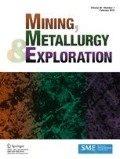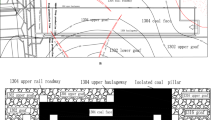Abstract
Many cases of derailments, train accidents and traffic interruptions due to the slope failure and rockfall have been reported in the past on Konkan Railway trackline because of unstable rock slopes. The authorities installed stability enhancement measures such as wire netting, rock bolting and shotcreting which were found insufficient. The failed geotechnical measures prompted authorities to excavate the unstable slopes. Rock blasting is generally not preferred for the excavation of slopes along the transportation route. Stabilisation and widening of slopes by blasting need closure of the route for a considerable time. Discontinuing traffic on Konkan Railway route was undesirable as it connects two important port cities Mumbai and Mangalore. The paper presents an innovative directional controlled blasting (DCB) technique for excavating three unstable slopes (i.e. cuttings) in hilly terrain without disturbing the traffic. New empirical formulae for small geometry blasting to estimate burden and throw have been developed. A unique sequence of firing and excavation with powder factor varying between 0.04 and 0.39 kg/m3 irrespective of the actual free face was used for rock blasting. The process controlled the throw of blasted material over the track and resulted in a smooth and stable wall. The slope angle has been changed from 80 to 82° to 45–47° and probability of wedge, planar and toppling failures was eliminated. About 100 such accident-prone slopes (52 km cumulative length, 7% of total route) situated at discrete locations along Konkan Railway route were stabilised using the technique. No incident of rockfall and slope failures along these slopes has been observed after the stabilisation.

















Similar content being viewed by others
Abbreviations
- DCB:
-
Directional controlled blasting
- KRCL:
-
Konkan Railway Corporation Limited
- RDSO:
-
Research Design and Standards Organization
- KMPH:
-
Kilometre per hour
- C1:
-
Veravali cutting
- C2:
-
Amdalli cutting
- C3:
-
Ulware cutting
- RQD:
-
Rock quality designation
- C:
-
Cohesion
- ϕ :
-
Friction angle
- σc :
-
Uniaxial compressive strength
- γ:
-
Density of rock
- σt :
-
Tensile strength
- E :
-
Young’s modulus
- mi :
-
Rock mass constant
- RMR:
-
Rock mass rating
- GSI:
-
Geological strength index
- DF:
-
Disturbance factor (1 for poor blasting)
- Jv :
-
Volumetric joint count number/m3
- Jn:
-
Joint set (n = 1 to 5)
- SL:
-
Slope orientation
- H:
-
Horizontal
- V:
-
Vertical
- B:
-
Burden
- S:
-
Spacing
- db :
-
Diameter of hole
- ρe :
-
Density of explosive
- g:
-
Acceleration due to gravity
- AWS:
-
Absolute weight strength
- Vo :
-
Velocity of throw
- TW :
-
Throw distance
- β :
-
Trajectory exit angle
- PF :
-
Powder factor
- Dh/B :
-
Stiffness ratio
- Dh :
-
Depth of hole
- WH:
-
Wall side hole
- PH:
-
Production hole
- LH:
-
Ledge side hole
- BH:
-
Buffer hole
- Exp.:
-
Explosive
- D-cord:
-
Detonating cord
- CR:
-
Cord relay
- Rn :
-
Row (n = 1 to 3)
- Pb :
-
Borehole pressure
- cd :
-
Velocity of detonation of explosive
- de :
-
Diameter of explosives charge
- Ra :
-
Axial decoupling
- PPV:
-
Peak particle velocity
- CPH:
-
Charge per hole
- MCPD:
-
Maximum charge per delay
- TC:
-
Total charge
- σdt :
-
Dynamic tensile strength
- Cp :
-
P wave velocity
- Min.:
-
Minimum
- Max.:
-
Maximum
- Eq.:
-
Equation
References
Barton N (1972) A model study of rock-joint deformation. Int J Rock Mech Min Sci 9(5):579–602
Bauer A (1982) Wall control blasting in open pits. In: Proceedings of the 14th Canadian Rock Mechanics Symposium, Vancouver, British Columbia, Canada, May 13-14, pp 3-10
BBC News-South Asia (2004) Rail crash due to natural cause. Retrieved from http://news.bbc.co.uk/2/hi/south_asia/3815573.stm.
Casale M, Oggeri C, Peila D (2008) Improvements of safety conditions of unstable rock slopes through the use of explosives. Nat Hazard Earth Sys 8:473–481. https://doi.org/10.5194/nhess-8-473-2008
Chiappetta RF (1991) Pre-splitting and controlled blasting techniques including air decks and dimension stone criteria. In: Proceedings of blast technology, instrumentation and explosives applications seminar. San Diego, USA, pp 176–186
Chiappetta RF (2001) The importance of pre-splitting and field controls to maintain stable high walls, eliminate coal damage and over break. In: Proceedings of 10th high-tech seminar on State of the art, blasting technology, instrumentation and explosives application, Nashville, TN, USA, GI-48, Jul 22-26, pp 22-26
Chung SH (1982) Computerized sinking cut design in open pit mining. CIM Special Volume 30. Rock Breaking and Mechanical Excavation, Vancouver, BC, May 13-14, pp 87–90
Chung SH, Tidman JP (1989) Effective modelling for cast blasting. Int J Min Reclam Environ 3(3):151–153. https://doi.org/10.1080/09208118908944268
Commissioner of Railway Safety (2009) Railway Accident Inquiry Reports. Retrieved from https://web.archive.org/web/20090410083737/http://civilaviation.nic.in/ccrs/accidents/2004-2005/DETAILS%202004-2005/ACCIDENT(iv)%20OF%202004-2005.htm.
Dengfeng SU (2019) Analysis on the influence factors of directional controlled blasting assisted by water jet. Journal of Geological Resource and Engineering 7:45–56. https://doi.org/10.17265/2328-2193/2019.02.002
Forsyth WW (1993) A discussion of blast-induced overbreak in underground excavations In: 4th International symposium on Rock Fragmentation by Blasting, Vienna, Austria, pp 161–166
Garg A, Shukla PR, Kapshe M (2007) From climate change impacts to adaptation: a development perspective for India. Nat Resour Forum 31(2):132–141. https://doi.org/10.1111/j.1477-8947.2007.00142.x
Hagan TN, Mercer JK (1983) Safe and efficient blasting in open pit mines. In: Proceedings of workshop held by ICI Australia Operations Ltd., Karratha, November, Australia, pp 23–25
Hindustan Times Correspondent (2003) 51 killed, many hurt in rare Konkan Railway mishap in Maharashtra. Hindustan News. Retrieved from https://www.hindustantimes.com/india/june-23-2003-51-killed-many-hurt-in-rare-konkan-railway-mishap-in-maharashtra/story-AFoyWFqBSZw90kSmci1KjN.html,
Hoek E, Carranza-Torres C, Corkum B (2002). Hoek-Brown failure criterion-2002 edition. In: Proceedings of NARMS-TAC 1(1), Mining Innovation and Technology, Toronto, University of Toronto. Retrieved from https://www.rocscience.com/help/rocdata/pdf_files/theory/Hoek-Brown_Failure_Criterion- 2002_Edition.pdf accessed 24 January 2019
Hustrulid W (1999) Blasting principal for open-pit mining. Volume 1-General design concept. A.A. Balkema, Rotterdam, Netherlands
Hustrulid W, Johnson J (2008) A gas pressure-based drift round design methodology. In: Proceedings of the 5th International Conference on Mass Mining, Lulea, June 9-11, pp 657-669
ICI (1991) Safe and efficient blasting in open cut mines and quarries, ICI Australia Operations Pty. Ltd.
ISEE (2011) Blasters’ handbook. 18th edition, International Society of Explosive Engineers, 30325 Bainbridge Road I Cleveland OH 44139
IS:11315 (Part 10) (1987) Method for the quantitative descriptions of discontinuities in rock masses. Indian Standard pp 1–12
Jimeno CL, Jimeno EL, Carcedo FJA (1995) Drilling and blasting of rocks. A. A. Balkema, Rotterdam, Netherlands
Kainthola A, Singh PK, Singh TN (2015) Stability investigation of road cut slope in basaltic rockmass, Mahabaleshwar, India. Geosci Front 6(6):837–845. https://doi.org/10.1016/j.gsf.2014.03.002
Konkan Railway (2008) Konkan Railway Geo-safety Works. Retrieved from http://www.konkanrailway.com/uploads/pdfs/Geo-tech-safety-works-nov-15.pdf.
Konya CJ, Walter EJ (1985) Rock blasting: seminar of blasting and overbreak control (No. FHWA/TS-85/225). Montville, OH, United States
Konya CJ, Walter EJ (1990) Surface blast design. Prentice Hall, Englewood Cliffs, New Jersey
Kuzmenko AA, Vorobev VD, Denisyuk II, Dauetas AA (1993) Seismic effects of blasting in rock. Oxford and IBH Publishing Co. Pvt. Ltd. New Delhi, India
Langefors U, Kihlstrom B (1963) The modern technique of rock blasting. John Wiley and Sons Inc, New York
Liu JZ, Xu JY, Lv XC, Zhao DH, Leng BL (2012) Experimental study on dynamic mechanical properties of amphibolites, sericite-quartz schist and sandstone under impact loadings. Int J Nonlinear Sci Numer Simul 13(2):209–217
Lundborg N (1981) The probability of flyrock. Swedish Detonic Research Foundation. Report DS.1981:5, Stockholm
Mandal SK, Singh MM, Dasgupta S (2008) Theoretical concept to understand plan and design smooth blasting pattern. Geotech Geol Eng 26(4):399–416. https://doi.org/10.1007/s10706-008-9177-4
Ma L, Li K, Ding X et al (2016) Development and application of blast casting technique in large-scale surface mines : a case study of Heidaigou surface coal mine in China. Shock Vib. https://doi.org/10.1155/2016/8496742
Mohamed F, Hafsaoui A, Talhi K, Menacer K (2015) Study of the powder factor in surface bench blasting. Proced Earth Plan Sc 15:892–899. https://doi.org/10.1016/j.proeps.2015.08.142
Nobel D (2010) Blasting and explosives quick reference guide. Dyno Nobel Asia Pacific Pty Limited, Kalgoorlie, REF0110/0210/AZZUS/2K
Palmstrom A (1982) The volumetric joint count-a useful and simple measure of the degree of rock mass jointing. In: Proceedings IV IAEG Congress. New Delhi, pp V221–V228
Radke, EHF (2016) Controlled directional blasting. International Publication Number WO 2016/205935 AI. Retrieved from https://patentimages.storage.googleapis.com/f6/65/e3/e32000a8be29ba/WO2016205935A1.pdf Accessed 02/02/2020
Ray SK, Zutshi A, Sarkar M (1999) Cast blasting-state of the art. Fragblast Int J Blasting Fragm 3(4):292–302. https://doi.org/10.1080/13855149909408054
RDSO (2005) Guidelines for cuttings in railway formations, GE:G-2, Geotechnical Engineering Directorate, Research Designs and Standards Organisation, Government of India, Ministry of Railways. Retrieved from https://rdso.indianrailways.gov.in/works/uploads/File/2(2).pdf.
Rustan RA (1992) Burden, spacing and borehole diameter at rock blasting. Int J Min Reclam Environ 6(3):141–149. https://doi.org/10.1080/09208119208944329
Sarma KS (1986) Optimum blast design - a guideline. Journal of Institution of Engineers (India), Mining Engineering Division 66: 27–30
Singh PK, Roy MP, Paswan RK (2014) Controlled blasting for long term stability of pit-walls. Int J Rock Mech Min Sci 70:388–399. https://doi.org/10.1016/j.ijrmms.2014.05.006
Tose SSJ (2007) A review of the design criteria and practical aspect of developing a successful pre-split. In: International Symposium on Stability of Rock Slopes in Open Pit Mining and Civil Engineering. Johannesburg, The South African Institute of Mining and Metallurgy, September 12-14, pp. 525–546
Trivedi R, Singh TN, Raina AK (2014) Prediction of blast-induced flyrock in Indian limestone mines using neural networks. J Rock Mech Geotech Eng 6(5):447–454. https://doi.org/10.1016/j.jrmge.2014.07.003
Venkatesh HS, Balachander R, Gupta RN (2005) Near field vibration monitoring for rock mass damage control. J Explos Eng 22(4):34–36
Widdowson M, Cox KG (1996) Uplift and erosional history of the Deccan traps, India evidence from laterites and drainage patterns of the Western Ghats and Konkan Coast. Earth Planet Sc Lett 137(1–4):57–69
Acknowledgements
The authors express their thankfulness to Director (Works), Chief Engineer, Sr. Regional Engineer of Karwar & Ratnagiri and other officials of KRCL for providing necessary facilities during field investigations. The permission of competent authority of CSIR-Central Institute of Mining and Fuel Research, Dhanbad, India, to publish the paper is thankfully acknowledged. Furthermore, the authors are also very much thankful to team members involved during the study and anonymous peer reviewers for their valuable comments to improve the quality of the manuscript.
Author information
Authors and Affiliations
Corresponding author
Ethics declarations
Conflict of Interest
The authors declare that they have no conflict of interest.
Additional information
Publisher’s Note
Springer Nature remains neutral with regard to jurisdictional claims in published maps and institutional affiliations.
Electronic supplementary material
ESM 1
(DOCX 34 kb)
Rights and permissions
About this article
Cite this article
Bhagat, N.K., Mishra, A.K., Singh, M.M. et al. Innovative Directional Controlled Blasting Technique for Excavation of Unstable Slopes Along a Busy Transportation Route: a Case Study of Konkan Railway in India. Mining, Metallurgy & Exploration 37, 833–850 (2020). https://doi.org/10.1007/s42461-020-00212-x
Received:
Accepted:
Published:
Issue Date:
DOI: https://doi.org/10.1007/s42461-020-00212-x




